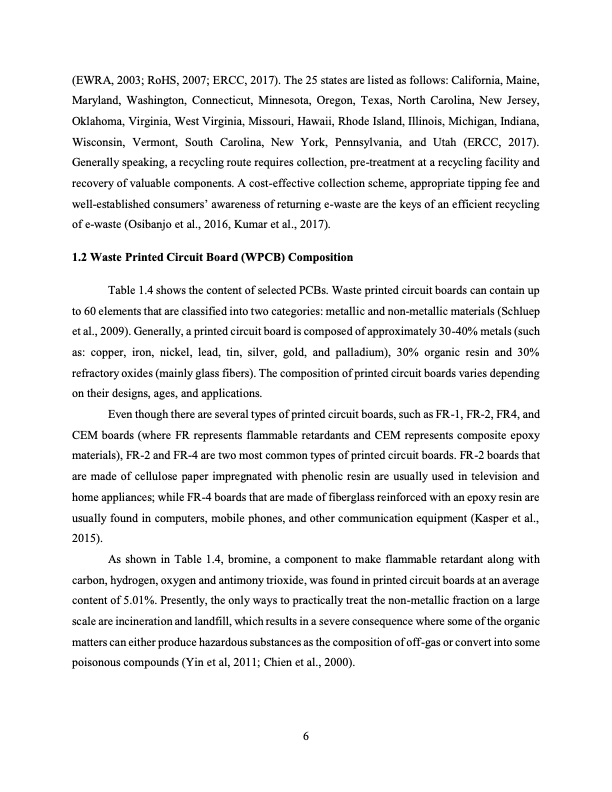
PDF Publication Title:
Text from PDF Page: 019
(EWRA, 2003; RoHS, 2007; ERCC, 2017). The 25 states are listed as follows: California, Maine, Maryland, Washington, Connecticut, Minnesota, Oregon, Texas, North Carolina, New Jersey, Oklahoma, Virginia, West Virginia, Missouri, Hawaii, Rhode Island, Illinois, Michigan, Indiana, Wisconsin, Vermont, South Carolina, New York, Pennsylvania, and Utah (ERCC, 2017). Generally speaking, a recycling route requires collection, pre-treatment at a recycling facility and recovery of valuable components. A cost-effective collection scheme, appropriate tipping fee and well-established consumers’ awareness of returning e-waste are the keys of an efficient recycling of e-waste (Osibanjo et al., 2016, Kumar et al., 2017). 1.2 Waste Printed Circuit Board (WPCB) Composition Table 1.4 shows the content of selected PCBs. Waste printed circuit boards can contain up to 60 elements that are classified into two categories: metallic and non-metallic materials (Schluep et al., 2009). Generally, a printed circuit board is composed of approximately 30-40% metals (such as: copper, iron, nickel, lead, tin, silver, gold, and palladium), 30% organic resin and 30% refractory oxides (mainly glass fibers). The composition of printed circuit boards varies depending on their designs, ages, and applications. Even though there are several types of printed circuit boards, such as FR-1, FR-2, FR4, and CEM boards (where FR represents flammable retardants and CEM represents composite epoxy materials), FR-2 and FR-4 are two most common types of printed circuit boards. FR-2 boards that are made of cellulose paper impregnated with phenolic resin are usually used in television and home appliances; while FR-4 boards that are made of fiberglass reinforced with an epoxy resin are usually found in computers, mobile phones, and other communication equipment (Kasper et al., 2015). As shown in Table 1.4, bromine, a component to make flammable retardant along with carbon, hydrogen, oxygen and antimony trioxide, was found in printed circuit boards at an average content of 5.01%. Presently, the only ways to practically treat the non-metallic fraction on a large scale are incineration and landfill, which results in a severe consequence where some of the organic matters can either produce hazardous substances as the composition of off-gas or convert into some poisonous compounds (Yin et al, 2011; Chien et al., 2000). 6PDF Image | HYDROMETALLURGICAL TREATMENT OF E-SCRAP

PDF Search Title:
HYDROMETALLURGICAL TREATMENT OF E-SCRAPOriginal File Name Searched:
Cui_mines_0052E_11489.pdfDIY PDF Search: Google It | Yahoo | Bing
NFT (Non Fungible Token): Buy our tech, design, development or system NFT and become part of our tech NFT network... More Info
IT XR Project Redstone NFT Available for Sale: NFT for high tech turbine design with one part 3D printed counter-rotating energy turbine. Be part of the future with this NFT. Can be bought and sold but only one design NFT exists. Royalties go to the developer (Infinity) to keep enhancing design and applications... More Info
Infinity Turbine IT XR Project Redstone Design: NFT for sale... NFT for high tech turbine design with one part 3D printed counter-rotating energy turbine. Includes all rights to this turbine design, including license for Fluid Handling Block I and II for the turbine assembly and housing. The NFT includes the blueprints (cad/cam), revenue streams, and all future development of the IT XR Project Redstone... More Info
Infinity Turbine ROT Radial Outflow Turbine 24 Design and Worldwide Rights: NFT for sale... NFT for the ROT 24 energy turbine. Be part of the future with this NFT. This design can be bought and sold but only one design NFT exists. You may manufacture the unit, or get the revenues from its sale from Infinity Turbine. Royalties go to the developer (Infinity) to keep enhancing design and applications... More Info
Infinity Supercritical CO2 10 Liter Extractor Design and Worldwide Rights: The Infinity Supercritical 10L CO2 extractor is for botanical oil extraction, which is rich in terpenes and can produce shelf ready full spectrum oil. With over 5 years of development, this industry leader mature extractor machine has been sold since 2015 and is part of many profitable businesses. The process can also be used for electrowinning, e-waste recycling, and lithium battery recycling, gold mining electronic wastes, precious metals. CO2 can also be used in a reverse fuel cell with nafion to make a gas-to-liquids fuel, such as methanol, ethanol and butanol or ethylene. Supercritical CO2 has also been used for treating nafion to make it more effective catalyst. This NFT is for the purchase of worldwide rights which includes the design. More Info
NFT (Non Fungible Token): Buy our tech, design, development or system NFT and become part of our tech NFT network... More Info
Infinity Turbine Products: Special for this month, any plans are $10,000 for complete Cad/Cam blueprints. License is for one build. Try before you buy a production license. May pay by Bitcoin or other Crypto. Products Page... More Info
| CONTACT TEL: 608-238-6001 Email: greg@infinityturbine.com | RSS | AMP |